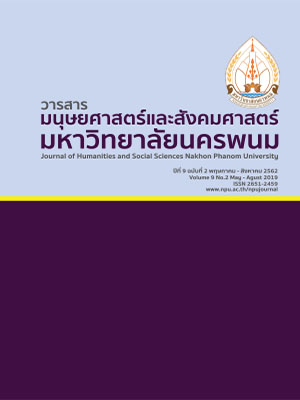Upgrading the Cultural Tourism Market in Sing Buri Province by the Community
Main Article Content
Abstract
The purpose of this research is 1) to identify the tourism identities in Singburi Province. 2) to study the tourism marketing operation in Singburi Province, and 3) to guidelines of the Enhancing for cultural tourism marketing in Singburi Province by Community-based. This research uses qualitative methods with key informants 23 people who related with tourism in Singburi Province. Select respondents will use the purposive sampling method. The target respondents will be 7 state agency personnel, 8 private institute personnel or entrepreneurs, 8 local residents. Using with data collecting by in-depth interview. The instrument quality was found by an analysis of content validity from 3 experts and the correspondence index value was 1.00 in all factors. The instrument used for collecting data was semi structure in-depth interview. This study uses a descriptive technique to analyze the data.
The study shows that 1) Singburi Province is the provinces that owns outstanding cultures. It possesses lots of cultural capitals which is able to be developed into having cultural attractions appealed to the tourists and generated the Economic Value-Added (EVA) to the province. 2) The important issue was found from the studied that the operation of marketing for tourism in Singburi Province which was consists of Product, Price, Place, Promotion, People, Process and Physical evidence. 3)The improvement approach of enhancing for cultural tourism marketing in Singburi Province by Community revealed that the provincial administrators should promote the public relations to persuade and to convince the tourists; improve the tourist attraction presentation in various approaches; create the tourism officers to narrate the tourist attraction in an interesting manner
Article Details
References
สำนักงานเกษตรและสหกรณ์จังหวัดสิงห์บุรี. (2558). ข้อมูลการเกษตรและสหกรณ์จังหวัดสิงห์บุรี. สิงห์บุรี : ม.ป.ท.
Artuge, S. & Cevdet, B. (2013). The effect of destination image on destination loyalty: An application in Alanya. European Journal of Business and Management, 3(5), 12.
Buchert (2015). The role of heritage tourism in the Shetland Islands. International Journal of Culture, Tourism and Hospitality Research, 4, 129.
Lovelock, Christopher H. & Jochenl, Wirtz. (2007). Service marketing: People technology, strategy. Boston, MA: Prentice Hall.
Cheung, W. (2016). Induced nostalgia increases optimism among individuals high, but not low, in trait nostalgia. Personality and Individual Differences, 90, 283–288.
Dillimono, H.D. & Dickinson, J.E. (2015). Travel, tourism, climate change, and behavioral change: Travelers’ perspectives from a developing country, Nigeria. J. Journal of Sustain Tour, 23, 437–454.
Fainstein, S. S. (2015). Tourism and the Commodification of Urban Culture. The Urban Reinventions. Canary Island : University of Tenerife
Heryanto, H. (2011). Effect of marketing strategy on customer loyalty Bajapuik Saving at PT. BPR Berok Gunung Pangilun Padang. International Journal of Lean Thinking, 2(1), 59-87.
Jame, M. (2001). Total Quality in Marketing. Florida : St Lucie.
Kotler P. (2001). Marketing management. New York : Prentice-Hall.
Meng, R & Uysal,N. (2014) . Effects of gender differences on perceptions of destination Attributes, motivations and travel values: An examination of nature-based resort destination. Journal of Sustainable Tourism.Vol.16, No.4, pp.445-466.
Mullins, J., & Walker, O. (2010). Marketing management: A strategic decision-making approach (7th ed.). Boston : McGraw-Hill Irwin.
Pitchford, S. (2008). Identity Tourism : Imaging and Imagining the nation. UK.: Emerald Group Publishing Ltd.
Sampson, P. M.J. (1967). Commonsense in qualitative research. Journal of the Market Research Society. 9(1), 30-38.
UNCTAD. (2015). Creative Economy Report. Retrieved July 2017 from ; http://www.unctad.org/en/docs/ditc.
Zeithaml, V.A. (2006). Delivering Quality Service:Balancing Customer Perceptions and Expectations. New York : The Free Press.


